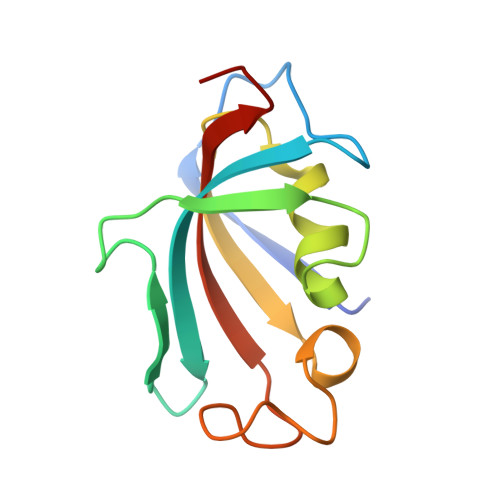Leveraging Fungal and Human Calcineurin-Inhibitor Structures, Biophysical Data, and Dynamics To Design Selective and Nonimmunosuppressive FK506 Analogs.
Gobeil, S.M., Bobay, B.G., Juvvadi, P.R., Cole, D.C., Heitman, J., Steinbach, W.J., Venters, R.A., Spicer, L.D.(2021) mBio 12: e0300021-e0300021
- PubMed: 34809463
- DOI: https://doi.org/10.1128/mBio.03000-21
- Primary Citation of Related Structures:
6VCT, 6VCU, 6VCV, 6VRX - PubMed Abstract:
Calcineurin is a critical enzyme in fungal pathogenesis and antifungal drug tolerance and, therefore, an attractive antifungal target. Current clinically accessible calcineurin inhibitors, such as FK506, are immunosuppressive to humans, so exploiting calcineurin inhibition as an antifungal strategy necessitates fungal specificity in order to avoid inhibiting the human pathway. Harnessing fungal calcineurin-inhibitor crystal structures, we recently developed a less immunosuppressive FK506 analog, APX879, with broad-spectrum antifungal activity and demonstrable efficacy in a murine model of invasive fungal infection. Our overarching goal is to better understand, at a molecular level, the interaction determinants of the human and fungal FK506-binding proteins (FKBP12) required for calcineurin inhibition in order to guide the design of fungus-selective, nonimmunosuppressive FK506 analogs. To this end, we characterized high-resolution structures of the Mucor circinelloides FKBP12 bound to FK506 and of the Aspergillus fumigatus, M. circinelloides , and human FKBP12 proteins bound to the FK506 analog APX879, which exhibits enhanced selectivity for fungal pathogens. Combining structural, genetic, and biophysical methodologies with molecular dynamics simulations, we identify critical variations in these structurally similar FKBP12-ligand complexes. The work presented here, aimed at the rational design of more effective calcineurin inhibitors, indeed suggests that modifications to the APX879 scaffold centered around the C 15 , C 16 , C 18 , C 36 , and C 37 positions provide the potential to significantly enhance fungal selectivity. IMPORTANCE Invasive fungal infections are a leading cause of death in the immunocompromised patient population. The rise in drug resistance to current antifungals highlights the urgent need to develop more efficacious and highly selective agents. Numerous investigations of major fungal pathogens have confirmed the critical role of the calcineurin pathway for fungal virulence, making it an attractive target for antifungal development. Although FK506 inhibits calcineurin, it is immunosuppressive in humans and cannot be used as an antifungal. By combining structural, genetic, biophysical, and in silico methodologies, we pinpoint regions of the FK506 scaffold and a less immunosuppressive analog, APX879, centered around the C 15 to C 18 and C 36 to C 37 positions that could be altered with selective extensions and/or deletions to enhance fungal selectivity. This work represents a significant advancement toward realizing calcineurin as a viable target for antifungal drug discovery.
Organizational Affiliation:
Department of Biochemistry, Duke Universitygrid.26009.3d, Durham, North Carolina, USA.














